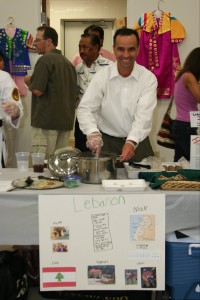John and I participated in the International Food Fest a few weeks ago at Holy Family Catholic Church here in Elizabeth City. John and I represented Lebanon. John’s grandmother was Lebanese and he grew up with his grandmother, mother and aunts preparing these tasty dishes.
Lebanese cooking has been said to be a labor of love, a thorough process that takes time and follows with the reward of enjoying the flavorful dishes. Our directions from John’s Aunt Mike included making the “sign of the cross” with the olive oil over the dishes to bless those who produced the food and all those who will eat it.
We made Kibbe and Tabouli. John and I spent a Friday afternoon pounding, preparing and baking Kibbee. It has been said that you could always tell when Kibbe was being made in a Lebanese home as the entire neighborhood could hear the pounding. The aroma in our kitchen Friday night was out of this world and certainly worth all of the hard work!
Kibbe or Kibbeh is a Levantine Arab dish and is traditionally prepared with chopped lamb (we used very lean ground beef), burghul (or bulgar/cracked wheat), sweet onion, garlic, fresh mint & parsley, olive oil and pine nuts. There are many different ways to prepare Kibbe. We made ours into meat balls and baked them. Kibbe is served with plain yogurt and wrapped in Syrian bread (Syrian bread is a soft bread similar to pita bread but without the “pocket”).
Tabouli, tabbouleh, or tabouleh is also a Levantine Arab dish and is made of bulgur wheat, fresh mint & parsley, onions, garlic, tomatoes, cucumbers, olive oil, Lebanese olives and lemon juice. In Lebanon, tabouli is served with Syrian bread and scooped out of a common container.
We had a great time making and enjoying these dishes with others. Nutritionally, these foods are very high in fiber, antioxidants and mononunsaturated fat. But, eating them is the ultimate reward … fresh, healthy and full of flavors.
~ Angie

Leave a Reply